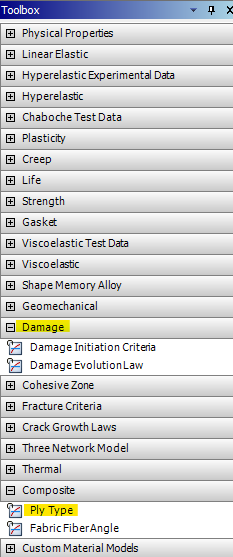-
-
April 17, 2022 at 8:12 pm
koushalk2000
SubscriberI am doing my project on composite overwrapped pressure vessel and i am trying to do structural analysis of two variant of pressure vessel with different material.
I want to know the actual burst pressure where my vessel is failing.
I am new to ansys, so for now i am using composite failure tool>inverse reverse factor to check whether my model fails at certain pressure or not. So, if the factor is greater than 1 at 25 MPa so i am saying the composite overwrapping has failed at this pressure. But i want to know the actual pressure where my pressure vessel is failing.
April 18, 2022 at 12:19 pmAshish Khemka
Forum Moderator
One of the approaches that I have used for steel material is to see at what pressure element distortion begins.
Regards Ashish Khemka
April 18, 2022 at 8:04 pmSean Harvey
Ansys Employee
Just to elaborate a bit on what Ashish has pointed out. So if you model a COPV. You can specify a failure on the composite as you indicated. This will give you FPF (first ply failure) The actual ultimate failure will likely come later and this depends on the layup and thickness of the liner, etc.
What you can do is specify a plasticity model for the liner. And a damage model for the composite.
 You then provide a pressure beyond which you feel the design can withstand ( not excessive, but still realistic), Turn on large deflection and specify auto time stepping on, initial, min, and max time steps or substeps.
You then provide a pressure beyond which you feel the design can withstand ( not excessive, but still realistic), Turn on large deflection and specify auto time stepping on, initial, min, and max time steps or substeps.
As the pressure increases, the composite may fail from the damage model and the load transfers to the liner and it yields. Incrementally more pressure is added till the solver can not converge and the elements begin to excessively distort. So in this case the solution will not converge, but you can look at the strains and deformations and you will see for a small increment in added pressure you get a larger increment of displacement or strain and the tank is now unstable. You can then use the last converged results to estimate your ultimate strength.
Try this and see if it helps or if you have further questions.
Regards Sean
May 2, 2022 at 7:24 pmkoushalk2000
SubscriberThanks
May 2, 2022 at 7:24 pmkoushalk2000
SubscriberThank you very much for this.. it helped me a lot
May 2, 2022 at 7:37 pmSean Harvey
Ansys EmployeeFantastic! Thanks for the feedback.
Regards Sean
March 9, 2023 at 1:42 pmMert ÖZKAN
SubscriberHello Mr. Harvey,
I did everything what you told. But I missed something I think. My solutions are so lineer and I couldn't predict where is the burst point on the graph. Could you explain the graphs and unconverged point that you predict with some pictures?
Best regards,
Mert
April 11, 2023 at 12:06 pmmertozkan
SubscriberI am doing pressure vessel analysis on Ansys as you told. But while I am modeling a Type-4 pressure vessel with Ansys's engineering data as polyethylene all the analysis ends at 25 MPa whatever I have changed. If I model a type-5 linerless composite tank instead of a type-4 plastic liner tank analysis in Ansys, how would it be realistic in burst pressure? Is it able to predict the burst pressure with a linerless as close as Type-4 composite pressure vessel?
Mert
Viewing 7 reply threads- The topic ‘How to find burst pressure of a pressure vessel in ansys ?’ is closed to new replies.
Ansys Innovation SpaceTrending discussionsTop Contributors-
2918
-
970
-
852
-
599
-
591
Top Rated Tags© 2025 Copyright ANSYS, Inc. All rights reserved.
Ansys does not support the usage of unauthorized Ansys software. Please visit www.ansys.com to obtain an official distribution.
-
We have an exciting announcement about badges coming in May 2025. Until then, we will temporarily stop issuing new badges for course completions and certifications. However, all completions will be recorded and fulfilled after May 2025.









